| The Florida tarpon mini-series covers
all aspects of fishing Florida Giant tarpon on the saltwater flats and
backcountry of Boca Grande, Tampa Bay, St. Petersburg, Clearwater, Tampa,
Orlando, and the Disney area. Learn tarpon biology to the charter secrets
of Florida tarpon fishing guide, Capt. Robert McCue. Whether you
are a flyfishing guru or a light tackle warrior, the tarpon mini-series
offers Florida tarpon fishing tips for pros and novices alike. We invite
you to review the entire Bounty Hunter Florida Sport Fishing Charters & Guide
Service site in making your decision upon taking Florida fishing charter.
|
PART TWO
| Tarpon Fishing Part I | Tarpon Fishing Part III | Tarpon Fishing Part IV |
![]()
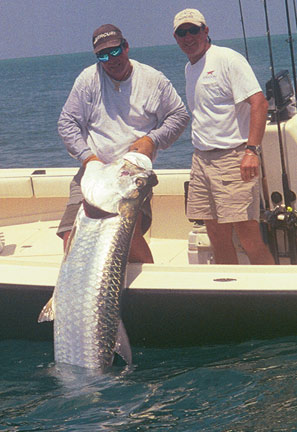 Here they come, one o'clock a big wad" I said, as I hit the
hi-bypass of my electric trolling motors to intercept the path of the giant tarpon. Their black mass just visible in
the light green Florida saltwater, 500 yards off the beach. A few fish roll, their giant
eyes looking right at us. "Give 'em the filet mignon" I suggested to the stunned
angler. The blue crab lands well ahead of the school and slowly sinks out of sight as the
huge mass of tarpon closes in. The rod tip bounces and the angler cranks the handle of the
large spinning reel in a fury to come tight to the beast. "Jab 'em, hit him
again," my voice cracks with a rush of adrenaline, like a trainer in Mike Tyson's
corner during a title fight. A 5-foot surface- to-air- tarpon missile launches, the
gills rattle like a threatened diamondback as the king walks on his tail across water. The
tarpon beast cartwheels in attempt to throw the razor sharp hook. Its body lights up
in a array of silver and so does the angler, and the guide wonders, who hooked who?
Another Florida tarpon fishing charter success story, another Florida tarpon gone bad. Here they come, one o'clock a big wad" I said, as I hit the
hi-bypass of my electric trolling motors to intercept the path of the giant tarpon. Their black mass just visible in
the light green Florida saltwater, 500 yards off the beach. A few fish roll, their giant
eyes looking right at us. "Give 'em the filet mignon" I suggested to the stunned
angler. The blue crab lands well ahead of the school and slowly sinks out of sight as the
huge mass of tarpon closes in. The rod tip bounces and the angler cranks the handle of the
large spinning reel in a fury to come tight to the beast. "Jab 'em, hit him
again," my voice cracks with a rush of adrenaline, like a trainer in Mike Tyson's
corner during a title fight. A 5-foot surface- to-air- tarpon missile launches, the
gills rattle like a threatened diamondback as the king walks on his tail across water. The
tarpon beast cartwheels in attempt to throw the razor sharp hook. Its body lights up
in a array of silver and so does the angler, and the guide wonders, who hooked who?
Another Florida tarpon fishing charter success story, another Florida tarpon gone bad.A moment of a lifelong memory? Yes. A rare occurrence? Not really, after all, we're fishing giant tarpon on the Gulf Coast of Florida.The scene is played out day in and day out all along our beautiful coast. |
As I mentioned in the introduction to fishing tarpon,
the silver king arrives along the West Coast of Florida on or about the first moon
in March most years. Action heats up in April and peaks in May, June, July, all
along our beaches and saltwater flats. This, all part of a tarpon pre-spawn
courtship ritual that has been happening as long as anyone can remember.
An hour before first light, I launch my 23-foot tarpon skiff the
"Bounty Hunter". Her trolling motors rigged, batteries charged, a arsenal of
rods point to the fish gods in every rod holder, the tarpon war machine is ready for
battle, another fun day in the Florida sun. The location of my tarpon charters may vary
somewhat according to particular moon phases and movements of the giant tarpon. For this
reason the "Bounty Hunter" is stowed on her trailer, giving me the mobility to
act as a tarpon fishing nomad and necessary to keep my clients in the highest
concentration of tarpon all year. I am a firm believer in the odds game.
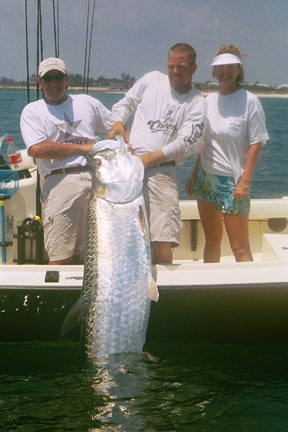 I make my run to the tarpon battlefield in the early morning darkness and
kill my Mercury 225 Opti
Max. a half-hour before first light in the theater of probability. Tarpon
hate outboards, (they may not chase them away...but do change their temperament in
shallower water) and I feel it's very important not to "run" anywhere you expect
them to be. As the sun rises, all eyes study the water for signs
of the tarpon. Tarpon almost always give themselves away by "rolling" on the
surface, other times they may "fin," just a portion of their tail or dorsal
breaks the surface. Other times a "pop" will be heard of the feeding
"poon". If none are spotted after a patient "stakeout", I will move
well outside of the anticipated travel path of the fish and slowly idle northward parallel
to the beach thus as I expect the tarpon to be generally moving south in early spring.
Stalking tarpon is similar to buck hunting, except it's a little bit warmer! We are always
staked out some where waiting. This is a major part of tarpon fishing. If you are one who
is not this type we suggest fishing for another species. Of course, the payoff is huge. I make my run to the tarpon battlefield in the early morning darkness and
kill my Mercury 225 Opti
Max. a half-hour before first light in the theater of probability. Tarpon
hate outboards, (they may not chase them away...but do change their temperament in
shallower water) and I feel it's very important not to "run" anywhere you expect
them to be. As the sun rises, all eyes study the water for signs
of the tarpon. Tarpon almost always give themselves away by "rolling" on the
surface, other times they may "fin," just a portion of their tail or dorsal
breaks the surface. Other times a "pop" will be heard of the feeding
"poon". If none are spotted after a patient "stakeout", I will move
well outside of the anticipated travel path of the fish and slowly idle northward parallel
to the beach thus as I expect the tarpon to be generally moving south in early spring.
Stalking tarpon is similar to buck hunting, except it's a little bit warmer! We are always
staked out some where waiting. This is a major part of tarpon fishing. If you are one who
is not this type we suggest fishing for another species. Of course, the payoff is huge.
As soon as I spot the tarpon fish, I turn the big motor off and make my final approach and adjustments with a pair of high-thrust electric trolling motors. The same technique is used when I am tarpon fishing on the saltwater flats, with the exception that I never use a gas motor in hunting tarpon in shallow water. Tarpon on the beach are often found in 8 to 25 feet of water and can tolerate a gas motor idling a few hundred yards away.
|
Tarpon
on the Florida flats will not stand for a gas motor in the clear shallows. At a good
distance the fish may not "spook" but their feeding will turn off. Flats tarpon
are always "spooky." I search for these fish using a combination of the
push-pole and electric motors, and only approach to make a presentation via push-pole, as
these fish are sensitive to the whirl of the electric's. The key to catching Florida flats
and beach tarpon is to be patient. An angler who stakes out an area is more likely to
encounter "happy" tarpon than those who insist on moving at fish quickly.
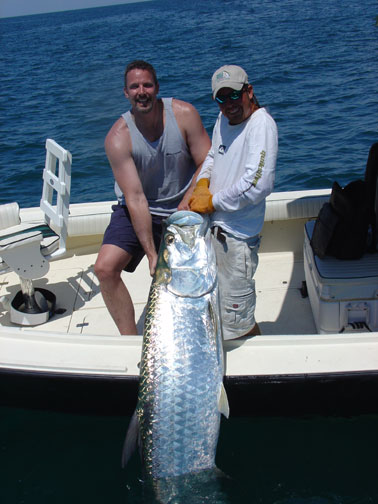
I often sit outside of pods of tarpon and study their movements, their speed, and the
attitude of the fish. If the tarpon( as they often do around the moons and in the early
season) are moving fast and rolling high ("greyhounding") and the area has a lot
of fish moving through, I will often let these "greyhounding" fish pass on.
These tarpon fish are hurried, and about as likely to stop as the average guy late for a
date with Demi Moore. Remember, these are pre-spawn fish. By letting them pass I can
concentrate on finding "happy" fish, those moving slowly, milling or stopping to
feed. A properly presented bait to these fish will often result in a hookup. If the pods
are coming infrequently I'll work all schools I can. Being able to make quick, yet patient
decisions is also key in catching beach and saltwater flats tarpon.
As I mentioned in the introduction to tarpon, a key factor is finding northbound schools
on the beach. This situation occurs mostly after the first full moon in June.
Northbound tarpon are post-spawn. Southbound tarpon are mostly pre-spawn. Southbound fish
can require presenting the bait a multiple of times. Like putting a peanut on the table of
a poker game, eventually somebody is going to eat it.The northbound tarpon are hungry.
They may have just completed the rigorous act of spawning and in addition just made it in
from the continental shelf 125 miles off shore and are returning to their normal habits.
If there is anything normal about tarpon!
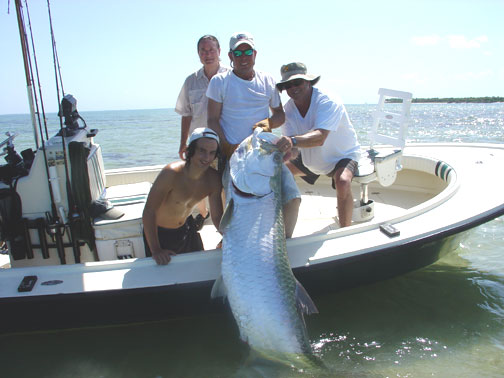 After finding "happy" tarpon,
and approaching them cautiously a proper presentation and a bite is all you need
to complete the hunt. As you sit well ahead of the fish, prepare to make your final
adjustments with the push-pole or trolling motor. As the fish close within 50 feet, take
your shots directly off the bow and not at the fish. On the beach this will allow your
bait to sink 8-10 feet, just barely above the tarpon's head and line of sight. The big
mistake made by many on our fishing charters is casting directly at rolling fish. Rolling
fish don't often bite, the tarpon below do. A bait on a tarpon's head or your line across
one's back will spook that fish and the school in turn. Also, a bait on the surface or
just bellow the surface will not always be seen by the eaters near the bottom. Not to
mention that a 6-foot tarpon knows not many things only 2 inches long have the nerve to
charge them. A 50-foot distance is about right, with 100 feet getting the nod on
greyhounders. Overcastting is a good idea as you can always reel the bait back toward the
fish quickly and silently. This technique works well on spooky flats tarpon too.
After finding "happy" tarpon,
and approaching them cautiously a proper presentation and a bite is all you need
to complete the hunt. As you sit well ahead of the fish, prepare to make your final
adjustments with the push-pole or trolling motor. As the fish close within 50 feet, take
your shots directly off the bow and not at the fish. On the beach this will allow your
bait to sink 8-10 feet, just barely above the tarpon's head and line of sight. The big
mistake made by many on our fishing charters is casting directly at rolling fish. Rolling
fish don't often bite, the tarpon below do. A bait on a tarpon's head or your line across
one's back will spook that fish and the school in turn. Also, a bait on the surface or
just bellow the surface will not always be seen by the eaters near the bottom. Not to
mention that a 6-foot tarpon knows not many things only 2 inches long have the nerve to
charge them. A 50-foot distance is about right, with 100 feet getting the nod on
greyhounders. Overcastting is a good idea as you can always reel the bait back toward the
fish quickly and silently. This technique works well on spooky flats tarpon too.
A unique situation on the flats is a
"laid up" tarpon. These fish are suspended motion-less just under the surface.
We can either see the fish from a short distance under the water, or the tips of their
fins break the surface. What these fish are doing is the speculation of much discussion.
Some believe they are sleeping, others say they are resting after a long swim. One thing
is for certain, they don't like small baits in front of their noses. These tarpon are
extremely spooky. They are perfect for a well placed silent fly. Otherwise cast well ahead
of the fish and let your baits drift in front of the fish. Oh yea, HOLD ON!
On the Gulf coast of Florida flats and beaches ,tarpon etiquette is
an unwritten law. Respect other fisherman. Never get close to them. Never run your
outboard near them or the fish they worked hard to find. If you must work fish that
someone is on, stay at least 500 yards down from the direction the tarpon are moving. Get
in line with the path of the fish using your trolling motor or push-pole and make your
shots. If you don't hook-up, let the fish pass at least 500 yards and allow the other
boats to set up. This system is called "leap froging" and it is the only way
multiple boats can productively share pods of beach tarpon and flats tarpon. A boat with a
fish on always has priority. Allow the angler plenty of room to break his trophy out of
the school. Then the school will settle, and they are all yours. Working this way you may
quickly establish a fishing buddy on the beach.. Having a fishing buddy can be very
beneficial to you, particularly if you are visiting a new area.
 Tackle for this light tackle beach and flats fishing should be of good
quality and in top working order. On our fishing charters a medium spinning rod with a
reel capable of holding 250 yards of 20-pound test is standard. You will be encountering
fish averaging 100 pounds, but could push 200. Tackle can be scaled up or down
depending on your skill. The 20-pound gear offers lots of fun and a challenge, and allows
a healthy release of these beautiful animals. Hooks should be heavy duty and very sharp.
An 80- to 125-pound-test leader of a foot to six feet in length is a must, with
length and strength being decided by the technique you prefer.The one bait that stands alone when it comes to fishing Florida tarpon is a live blue
crab, with 2.5 to 4 inches being the size preferred by the pros. I like to fish them with
no weight or float under most situations, but many prefer them. Palm-size pinfish, grunts
and herring make great live baits. Dead bait in the form of pinfish and shad often will
out produce anything. This is a specialty of a few and I strongly recommend that unless
you know where to find the choice menhaden and know how to fish them, you should hire a
pro. For many the only way to take a tarpon is by using a piece of plastic or a feather as
bait. The Cotee Liv'
Eye action jig with a 4 inch shad tail is highly productive, as is the 65M Mirrolure on the
beach and the 52M Mirrolure on the flats. Prime colors include red, green
or flame. Tackle for this light tackle beach and flats fishing should be of good
quality and in top working order. On our fishing charters a medium spinning rod with a
reel capable of holding 250 yards of 20-pound test is standard. You will be encountering
fish averaging 100 pounds, but could push 200. Tackle can be scaled up or down
depending on your skill. The 20-pound gear offers lots of fun and a challenge, and allows
a healthy release of these beautiful animals. Hooks should be heavy duty and very sharp.
An 80- to 125-pound-test leader of a foot to six feet in length is a must, with
length and strength being decided by the technique you prefer.The one bait that stands alone when it comes to fishing Florida tarpon is a live blue
crab, with 2.5 to 4 inches being the size preferred by the pros. I like to fish them with
no weight or float under most situations, but many prefer them. Palm-size pinfish, grunts
and herring make great live baits. Dead bait in the form of pinfish and shad often will
out produce anything. This is a specialty of a few and I strongly recommend that unless
you know where to find the choice menhaden and know how to fish them, you should hire a
pro. For many the only way to take a tarpon is by using a piece of plastic or a feather as
bait. The Cotee Liv'
Eye action jig with a 4 inch shad tail is highly productive, as is the 65M Mirrolure on the
beach and the 52M Mirrolure on the flats. Prime colors include red, green
or flame. |
Jigs and plugs should be examined as to their condition, as a tarpon will test
your tackle. If you have a weak link in the chain you can be assured the tarpon will find
it. Hooks should draw blood on the slightest touch. Tarpon have very tough bony jaws that
are very difficult to penetrate.
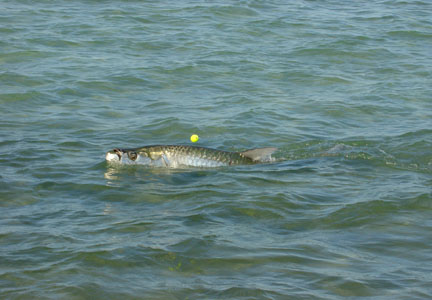 Saltwater flyfishing has become very popular over the last few years. I recommend that
those with little fly fishing experience or those who have never caught a tarpon on fly
apply their efforts toward the beach. You need not be a expert to hook up on fly with
beach tarpon, though being able to double-haul and cast somewhat accurately helps. Tarpon
on the beach are much easier to approach and the margin for error is greater. Florida
flats tarpon are very spooky, casting great distances accurately on heavier than normal
tackle is required. Just 20 miles of my house is the world-famous Homosassa tarpon flat.
Most world record tarpon on fly have been caught here. I must admit the tarpon fishing is
very demanding and over the years has become a little crowded, further, it's not as good
as it used to be. The area is regarded as reserved for fly fishing. Anglers interested in
trying it another way should take my warning and not go there unarmed! The fly is probably
the best way to hook a tarpon on the flats. A good cast is silent, swift and deadly on
these big fish. A 12- or 13-weight fly rod with a high quality reel and smooth drag are
standard tarpon tamers. Mono core "slime line" and 3M Mastery sinking tarpon
taper works great on the beach and has grown some popularity on the flats where floating,
weight-forward is the norm. Backing should be of 30-pound test, with 300 yards adequate
and 500 being better, as it increases the diameter of the arbor, making it easier to pick
up line quicker. Good flies are blue, purple and brown cockroaches and the "black
death" on the beach.
Saltwater flyfishing has become very popular over the last few years. I recommend that
those with little fly fishing experience or those who have never caught a tarpon on fly
apply their efforts toward the beach. You need not be a expert to hook up on fly with
beach tarpon, though being able to double-haul and cast somewhat accurately helps. Tarpon
on the beach are much easier to approach and the margin for error is greater. Florida
flats tarpon are very spooky, casting great distances accurately on heavier than normal
tackle is required. Just 20 miles of my house is the world-famous Homosassa tarpon flat.
Most world record tarpon on fly have been caught here. I must admit the tarpon fishing is
very demanding and over the years has become a little crowded, further, it's not as good
as it used to be. The area is regarded as reserved for fly fishing. Anglers interested in
trying it another way should take my warning and not go there unarmed! The fly is probably
the best way to hook a tarpon on the flats. A good cast is silent, swift and deadly on
these big fish. A 12- or 13-weight fly rod with a high quality reel and smooth drag are
standard tarpon tamers. Mono core "slime line" and 3M Mastery sinking tarpon
taper works great on the beach and has grown some popularity on the flats where floating,
weight-forward is the norm. Backing should be of 30-pound test, with 300 yards adequate
and 500 being better, as it increases the diameter of the arbor, making it easier to pick
up line quicker. Good flies are blue, purple and brown cockroaches and the "black
death" on the beach.
Action on the beach often is best at first light till noon when a sea breeze puts a chop
on the water and makes the fish hard to see. Action on the flats is best in the early
morning through the early afternoon, as the sun lights up the clear water, making the
tarpon easier to spot. This is particularly true over sand or the spotty bottom that
tarpon love.
In part three we will look at Boca Grande, the world's best tarpon fishing.
| Tarpon Fishing Part I | Tarpon Fishing Part III | Tarpon Fishing Part IV |
Please feel free to surf our whole Florida fishing site. We welcome your e-mail and invite you to call Capt. Robert McCue's--- Bounty Hunter Florida Sport Fishing Charters & Guide Service toll free for booking information.
Year 2008 Giant Tarpon Fishing Schedule
1+
(800) 833-0489
![]() Send
E-Mail To Capt.Robert@giantarpon.com
Send
E-Mail To Capt.Robert@giantarpon.com
| Home | Snook
| Flyfishing |
Testimonials | About
The Area | 200
lb Giant Tarpon Club |
| Fish'n Report | Links | Frequently Asked Questions | Species We Catch | Photos |
| Weather and Moon Phases | Video | In
The News ![]() | Newsletter | Featured
Articles
| Newsletter | Featured
Articles  | The
Lockjaw Tarpon Gaff ® |
| The
Lockjaw Tarpon Gaff ® |
This site contains tons of World Class Gamefish images. Please view the entire site to view these images.
Last Update 26AUG07
Copyright
1991-2007 Bounty Hunter Sport Florida
Fishing Charters & Guide Service Inc.
All Rights Reserved. Do not reproduce or distribute in any form.